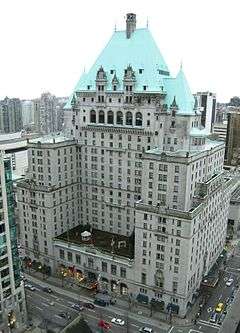Canadian Pacific Railway in British Columbia
The Canadian Pacific Railway is a Canadian Class I railway that stretches from Montreal, Quebec, to Vancouver, British Columbia. The British Columbia (BC) portion of the railway was constructed between 1881 and 1885, fulfilling a promise extended to BC when it entered Confederation in 1871[1]. For decades, it was the only practical means of long–distance passenger transport in Canada[2].
Background
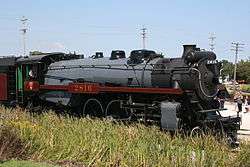
The Confederation League (which included such figures as Amor De Cosmos, John Robson, and Robert Beaven) led the chorus pressing for the colony to join Canada, which had been created out of three British North American colonies in 1867 (the Province of Canada, Nova Scotia and New Brunswick). Several factors motivated this drive—fear of annexation by the United States, overwhelming debt created by rapid population growth, the need for government-funded services to support this population, and the economic depression caused by the end of the gold rush. With the agreement by the Canadian government to extend the Canadian Pacific Railway to British Columbia and to assume the colony's debt, British Columbia became the sixth province to join Confederation on 20 July 1871. The borders of the province were not completely settled until 1903, however, when the province's territory shrank somewhat after the Alaska boundary dispute settled the vague boundary of the Alaska Panhandle.
Construction
The Pacific Scandal
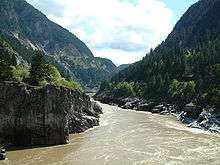
Sir John A. Macdonald's government fell in 1873 due to corruption in railway contracts[3]. Alexander Mackenzie succeeded Macdonald as Prime Minister and embarked on a very slow building process in Manitoba. At this time there was also a severe financial depression, due to the Credit Mobilier scandal and the building of the Union Pacific Railroad in the US. Also at this time, the government of Canada embarked on many surveys across the Rocky Mountains searching for the best route. Half a dozen routes were investigated, among them Pine Pass, Rocky Mountain Canyon, Yellowhead and Kootenay Crossing. These myriad surveys took time, effort and money—money which would have been better spent on just one or two surveys.
Macdonald returned to power in 1878 and truly began to get on with the job of the railway. The government of Canada contracted with Andrew Onderdonk to build a railway[4] two hundred miles from Port Moody on the Pacific tidewater to Savona's Ferry, some thirty miles west of modern Kamloops. Public Works Minister Sir Sandford Fleming had chosen the Fraser Canyon route with its fearsome Hell's Gate torrent, steep granite chasms, winding valleys and rockfalls. Other surveys had been conducted down Bute Inlet, Dean Channel, Howe Sound and Harrison Lake but were found wanting. Fleming favoured the Yellowhead Pass as the best route. At any rate, the blasting and tunnelling through the tortuous Pacific Cascade Mountains would take half-a-dozen years, and the route could drive from Kamloops to Jasper after Onderdonk's crews had finished.
Canadian Pacific Railway
The Canadian Pacific Railway Bill was approved by the House of Commons, and in February 1881 the company came into existence. It agreed to build the railway in exchange for $25,000,000 (approximately $625,000,000 in modern Canadian dollars) in credit from the Canadian government and a grant of 25,000,000 acres (100,000 km2) of land[5]. The government transferred to the new company those sections of the railway it had constructed. The government also defrayed the cost of surveying, and exempted the railway from property taxes for 20 years. The Montreal-based syndicate officially consisted of five men—George Stephen, James J. Hill, Duncan McIntyre, Richard B. Angus, and John Stewart Kennedy. Donald A. Smith and Norman Kittson were unofficial silent partners with a significant financial interest.
Chinese workers
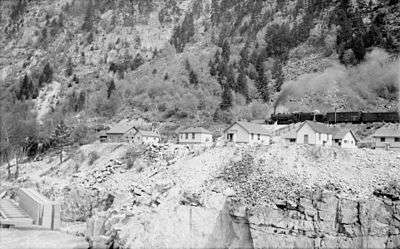

Due to a shortage of workers, Onderdonk contracted labour agents in Kowloon to supply six thousand Chinese coolies for the project. The province was outraged at the mass transfer of labour and "Asiatics", fearing that both would upset the white Anglo-Saxon classes in British Columbia. Macdonald ceded to Onderdonk, due to the savings in labour costs. BC at the time only had a population of two or three thousand Europeans—not nearly enough to build such a large project. Macdonald quipped that BC could either have Chinese workers and a railway, or no Chinese workers and no railway. Historians estimate he brought in a total of 15 000 Chinese from China and from California[6]. Chinese workers were kept on crews separate from the white workers and often given the most dangerous jobs, including tunnel-blasting using highly unstable nitroglycerin. Many Chinese laborers were killed in accidents or died of scurvy during the winter, though part of the blame for the scurvy deaths lay with the workers' reliance on rice as a staple. Unlike white workers, injured Chinese workers were not given access to the company hospital and were abandoned to the rest of the workers for help. Discrimination and racism led to fights between Chinese and white workers, including white foremen of Chinese crews. Chinese workers were generally seen by management as efficient, hardworking and well-behaved. The Chinese crews worked year-round in the cliffs and forests, leveling grades. Navvies received between $1 and $2.50 per day but had to pay for their own food, clothing, transportation to the job site, mail and medical care. After two-and-a-half months of back-breaking labour, they could net as little as $16. Chinese navvies in British Columbia made only between $0.75 and $1.25 a day (not including expenses), leaving hardly anything to send home. They did the most dangerous construction jobs. The families of the Chinese who were killed received no compensation—not even notification of loss of life. Many of the men who survived did not have enough money to return to their families in China and spent years in lonely, sad and (often) poor conditions.
Michael Haney
Onderdonk engaged Irishman Michael James Haney, a superior foreman. Haney saw the problem of the rivers, gorges, and cliffs and realized that Onderdonk would need extensive bridging. To solve this problem, Haney built a steam-powered sawmill at Haney to cut standardized timbers. Crews also cut bridge bents (framework reinforcements), so the advance crews only had to submit measurements to Haney and he would custom-build a woodwork for that mile marker of track. The prime Douglas fir of the Fraser Valley provided ideal timber. Lumber for ties was also cut at Texas Creek, and timber was cut at the Chehalis River near Kilby. Other crews were engaged around the province cutting and squaring crosstiea by the million.
1885: the critical year
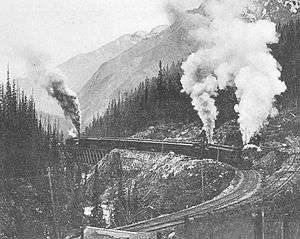
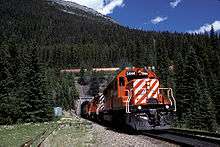
The ongoing cost of construction crews, crossing mountains, rivers and the Canadian Shield completely undid construction estimates and the CPR was nearly bankrupt in 1885. To prevent financial ruin CPR crews stopped building in masonry and steel, opting for tree-pole construction with bridge trestles built from nearby trees. Snowsheds, easy routings and sidings were omitted to reduce costs. Only the intervention of Lord Revelstoke of Barings Bank of London with another loan gave the CPR enough financing to finish the job. The greatest disadvantage of the route was in Kicking Horse Pass. In the first 6 km (3.7 mi) west of the 1,625-metre high (5,331 ft) summit, the Kicking Horse River drops 350 metres (1,148 ft). The steep drop would force the cash-strapped CPR to build a 7-kilometre (4.3 mi)-long stretch of track with a very steep 4.5% gradient when it reached the pass in 1884. This was over four times the maximum gradient recommended for railways of this era; even modern railways rarely exceed a 2% gradient. However, this route was far more direct than one through the Yellowhead Pass and saved hours for both passengers and freight. This section of track was the Big Hill. Safety switches were installed at several points, the speed limit for descending trains was set at 10 km/h (6.2 mph) and special locomotives were ordered. Despite these measures, several serious runaways still occurred. CPR officials insisted that this was a temporary expediency, but this state of affairs would last for 25 years until the completion of the Spiral Tunnels in the early 20th century.
Strike at Golden
Money problems triggered a strike at a construction camp near Golden in March, 1885. Work crews had not been paid for months, and downed their tools. The North-West Mounted Police and company foremen attempted to calm the situation. Promises were made by the company which ameliorated the stalemate, and the crews went back to work.
Last spike
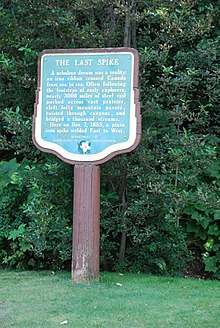
The North-West Rebellion in Saskatchewan was quickly put down with troops travelling over the CPR. Perhaps because the government was grateful for this service, it subsequently reorganized the CPR's debt and provided a further $5,000,000 loan—money which was desperately needed by the CPR. On November 7, 1885, the Last Spike was driven at Craigellachie, British Columbia, making good on the original promise. Four days earlier, the last spike of the Lake Superior section was driven just west of Jackfish, Ontario. While the railway was completed four years after the original 1881 deadline, it was completed more than five years ahead of the 1891 deadline issued by Macdonald in 1881.
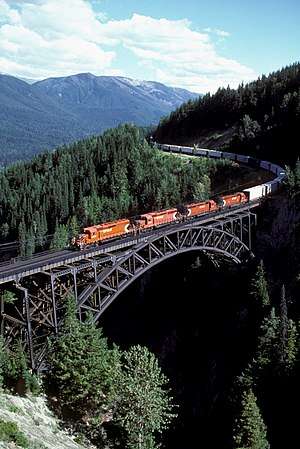
Extension of the line from Port Moody
After the completion of the through line to Montreal, Sir William Cornelius Van Horne looked at Port Moody and Burrard Inlet and decided to move the terminus to Gastown and False Creek. Land was secretly obtained from the provincial government and landowners to prevent speculation, and work crews extended the line 11 miles west to the City of Vancouver. Engine 374 pulled the first passenger train into Vancouver on May 23, 1887; it was a banner year for the city.
Canadian Pacific agents operated in many overseas locations. Immigrants were often sold a package that included passage on a CP ship, travel on a CP train, and land sold by the CP Railway priced at $2.50 an acre and up. Immigrants paid very little for a seven-day journey to the west. They rode in cars with sleeping facilities and a small kitchen at one end of each car. Children were not allowed off the train, lest they wander off and be left behind. The directors of the CPR knew that not only were they creating a nation, but also a long-term source of revenue for their company.
Since completion
Founding of Vancouver
Vancouver was founded in 1886 as an adjunct to the arrival of the railway. The CPR was given extensive lands in the Vancouver area—the West End, lands west of Cambie Street, False Creek and the Southlands area stretching to the Fraser River. Posh subdivisions were built, due to the railway's influence. The Drake Street Roundhouse was built on False Creek, and Yaletown emerged. The City of Vancouver was incorporated on 6 April 1886, the year the first transcontinental train arrived. The name (honouring George Vancouver) was chosen by CPR president William Van Horne, who arrived in Port Moody to establish the CPR terminus recommended by Henry John Cambie. A massive "slash burn" (clearing fire) broke out of control on 13 June 1886, razing the entire city. It was quickly rebuilt, and the Vancouver Fire Department was established that same year.
Enter the CPR Pacific Steamers
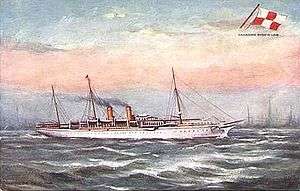
The CPR chartered ocean steamers Batavia, Abyssinia and Parthia to enter the China tea trade. The CPR then built their well-known Empress ships. The RMS Empress of China began liner service in 1891.
Profitability
The completion of the line and extension of the steamers put the railway in the black. From this, it began a program of infrastructure upgrades; the temporary trestles were changed to stone and steel. Snowsheds were built, as were rail yards, spurs, coalsheds and watertowers. The CPR sought cargo for its trains—lumber from the Hastings mill, fish from Steveston, fruit from the Okanagan, minerals from the Kootenays and immigrants from Europe. With this in mind, the railway expanded with spurs to the Okanagan, the Esquimalt and Nanaimo Railway, and a southern link from Port Coquitlam to New Westminster and Eburne.
Various disasters
While the CPR was doing well on the financial front, heavy slides in the Rogers Pass would often close the line in the month of March. Crews were dispatched to the area to shovel snow, which worked until 1910 when another slide came down on a work crew. Rains in 1894 washed out bridges and rail lines in a number of places. The line also had ongoing trouble with the Big Hill, including several runaway trains.
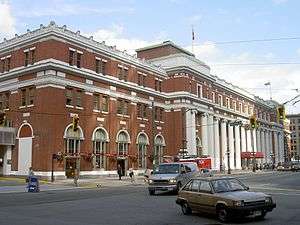
Turn of the century
By the turn of the 20th century, the railway was a going concern and made its mark on the world stage. Major hotels were begun, such as the Empress Hotel in Victoria, the Second Hotel Vancouver, Glacier House, the Banff Springs Hotel and Chateau Lake Louise. Heavier railway equipment was built and ordered to keep up with the increased tonnage, and with the heavier trains came heavier bridges. One ongoing problem was the onerous grade up the Kicking Horse Pass. The heavy trains needed batteries of engines to get over the Big Hill. From this the Spiral Tunnels evolved, and construction began to build the long tunnels under the mountains.
The Crow's Nest Pass
The CP empire had driven south from Calgary in the 1890s to reach the coal mines of Lethbridge; also, a link was made to the US lines in Montana. From this, the CPR wanted to build a line to the rich coalfields of Fernie over the Rocky Mountains in BC. A line was built from Alberta across the Crow's Nest Pass to Fernie and Cranbrook, and the mountains became littered with collieries. By 1900, the CPR had purchased the smelter at Trail and sought to move Fernie coal around the Selkirk Mountains to Nelson and Trail. When the CPR bought the smelter, it also bought the large mining company of Consolidated Mining and Smelting Company and their many properties in the Kootenays.
The Canadian Pacific Railway built a line from Lethbridge, Alberta, to a lakehead near Nelson, British Columbia; it opened in 1897. This line was built to develop coal deposits in the Elk River valley and help to assert Canadian (and CPR) sovereignty in an area into which U.S. railroads were beginning to build. CPR sought and received construction funding from the federal government, subject to a freight-subsidy arrangement for farm exports from the prairies; this came to be called the "Crow's Nest Pass Agreement". The tough lakeshore section around the Creston Mountains (from Creston to Nelson) was not built until 1927. Barges and lake steamers connected the railway.
Crow Rate
The Crow Rate or "Crow's Nest Freight Rate" was a subsidy offered to the Canadian Pacific Railway by the Canadian government. The subsidy was instituted by an 1897 agreement between the CPR and the federal government. The purpose of the subsidy was to enable the CPR to expand westward over the Canadian Rockies through the Crow's Nest Pass, while reducing the transportation costs for farmers in the Canadian Prairies. In exchange for cash and perpetual title to the CPR over the lands which the railway would run, the CPR would reduce shipping rates for listed agricultural products "forever".
CP in the Kootenays
The Columbia and Western Railway was a short-line, narrow-gauge railway running from the silver and gold mines at Red Mountain and Rossland down the hill to the smelter at Trail. It was bought by the CPR in 1898 for its charter; this gave it the authority to build westward to Grand Forks. Here it connected to the part of the original Kettle Valley Railway between Grand Forks and Midway which had also been purchased by the CPR. The Columbia and Western brought with it the smelter at Trail, which became the Consolidated Mining and Smelting Company Limited (later Cominco Ltd). The CPR also purchased the Columbia and Kootenay Railway and Navigation Company, which had a charter to construct a railway from Nelson to Robson (Castlegar, BC). Another purchase was the charter for the BC Southern Railway, which authorized the construction of a railway from the Crow's Nest Pass to Nelson. This line was initially constructed as far as the south end of Kootenay Lake at Kootenay Landing so through traffic had to transfer to a lake steamer and then reboard a second train for the final run into Nelson. The gap in the line from Kootenay Landing and Procter was not built until around 1932.
The Arrow Lakes route was accessible from the north, by a rail connection with the Canadian Pacific Railway at Revelstoke, where the CPR crosses the Columbia River. The CPR ran a spur line 30 miles south of Revelstoke to Arrowhead in 1891 to eliminate a stretch of difficult river navigation. The Arrow Lakes Route was also accessible from the south—at Northport, Washington, (also on the Columbia River) where there was a rail connection. The Columbia River crosses the border near Boundary, Washington, which is about 749 miles from the mouth of the Columbia. Thus, via a combination of steamboat and railway connections, travel was eased by the CPR.
The CPR also built rail lines to Sandon. The Nakusp and Slocan line went from Nakusp to Summit Lake, then down to Slocan Lake, past Rosebery, then up to Denver Canyon (New Denver). Then it drove up the hill along Carpenter Creek, to the mountainous mining town of Sandon. After the disastrous forest fire of 1911, the CPR bought the charred remains of the GN narrow gauge line Kaslo and Slocan Railway and rebuilt parts to standard gauge. The CPR then ran lake steamers and rail-car barges to link these disconnected lines over the lakes—from Kaslo to Nelson on Kootenay Lake; from Rosebery to Slocan City on Slocan Lake; and from Robson to Nakusp to Arrowhead (near Revelstoke) on the Arrow Lakes. The CPR attempted to build a connecting line from Lardeau, past Poplar Meadow—fifteen miles up the Lardeau River to Marblehead. Low traffic caused the line never to be finished to Trout Lake, Beaton and Arrowhead.
Building the Kettle Valley Railway
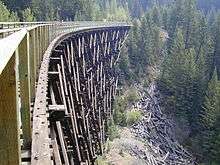
The CPR desired to have a second railway line across BC to service the rich farm, timber and mining lands in the Kootenays. It also wanted to lessen the impact of its rival Great Northern, which had easy access to the area from low valleys in Washington state. Through a long series of purchases, political machinations, lobbying, and due to the appearance of the GN, the Kettle Valley Railway was constructed from 1910 to 1915. The Kettle Valley Railway began at Hope and transited the Coquihalla Mountains to Brookmere, Tulameen, Princeton, Summerland, Penticton, Beaverdell and Midway. An additional spur line from the junction at Brodie connected the line through Merritt, British Columbia to Spences Bridge, British Columbia on the CPR main line. The Kettle Valley Railway operated as a wholly owned subsidiary of the CPR until it was absorbed by the CPR around 1937 as the Kettle Valley Division.
Lake steamers
The CPR ran a fleet of lake steamers on the Arrow Lakes, Kootenay and Slocan Lakes. They also had palatial ships on Okanagan Lake.
Coastal service in BC
BCCS was established when the CPR acquired the Canadian Pacific Navigation Company (and its large fleet of ships serving 72 ports along the coast of British Columbia, including Vancouver Island) in 1901. Service included the Vancouver-Victoria-Seattle Triangle Route, Gulf Islands, Powell River and a Vancouver-Alaska service. BCCS operated a fleet of 14 passenger ships made up of a number of Princess ships (pocket versions of the ocean-going Empress ships), a freighter, three tugs and five rail-car barges. Popular with tourists, the Princess ships were famous in their own right—especially the Princess Marguerite (II), which was the last coastal liner; it operated from 1949 until 1985. Three massive piers were built in Coal Harbour to service the boats—CPR Piers A, B and C, and D. B and C has since been converted to Canada Place Pier. Other impressive docks were built in Victoria and Nanaimo.
Silk trains
Between the 1890s and the 1940s, the CPR transported raw silk cocoons from Vancouver (where they had been shipped from the Orient) to silk mills in New York and New Jersey. A silk train could carry several million dollars worth of silk, and had its own armed guards. To avoid train robberies and minimize insurance costs, the silk trains traveled quickly and stopped only to change locomotives and crews (often done in under five minutes). The silk trains had right-of-way over all other trains; even passenger trains would be put in a siding to make the silk trains' trip faster.
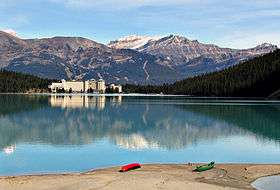
Expansion
The CPR embarked on facilities expansion during the Edwardian era. Large service yards were built at Port Coquitlam, Drake Street, Coal Harbour, and Cranbrook. Small feeder lines were built, such as the Marpole Line from Drake Street to Eburne and then to Steveston. A bridge was built southwards across the Fraser River at Mission, and a line was constructed to connect with the US Lines at Huntington (named for Collis P. Huntington, a US railway executive). The CP also built a hundred miles of rail down the Rocky Mountain trench from Golden to Creston, to more easily move heavy coal trains than over the winding and mountainous Kettle Valley Line. The coal was also needed on the main line for the steam engines. The Connaught Tunnel was built under Rogers Pass in 1913 to reduce grades there. Spur lines were built to various profitable mines around the province—to the Sullivan Mine at Kimberley, to copper mines at Phoenix, and south from Princeton to Allenby and Copper Mountain. A spur was built south of Penticton to Osoyoos. Large steel bridges were raised across the Fraser River at Hope and across the Columbia River at Revelstoke. The CPR embarked on a real estate expansion in Vancouver; it sold blocks of land to real-estate companies, which sold them for housing. The CPR also started the Shaughnessy Heights project of upscale estates, on a knoll at South Granville Street overlooking the city. Granville Street was established, and the finer residential suburb with curved streets, tree-lined avenues and strictly-controlled title deeds. The project did not sell as well as was hoped, due to the First World War and the Great Depression.
Competition

The CPR held a 25-mile monopoly on train service in BC from 1886; no competitor could work nearer its main line than that distance. By 1910, there were other players who wished to repeat the success of the CPR—the Grand Trunk Pacific Railway and the Canadian Northern Railway. Both lines arrived in BC but could not dislodge the CPR, which was firmly established in the southwest portion of the province. The CPR was given the Peace River Block in a land swap for acreage in the south; these lands turned out to be very rich in oil and gas.
First World War
Its lines had been completed, and it had fleets of trains and ships; men, ships and machines were loaned to the war effort. Bridges and rail installations were guarded by Canadian troops. The CPR provided essential service moving men, food, and guns for the war. Railway shops were converted to shell factories. [7]
Powerful engines
The Selkirk locomotives were 36 steam locomotives of the 2-10-4 wheel arrangement built for the Canadian Pacific Railway by Montreal Locomotive Works in Montreal. The first of these large engines with 2-10-4 wheel arrangement were built in July 1929. A total of twenty were constructed before the end of the year, bearing numbers 5900 to 5919. The Canadian Pacific Railway's classification was T1a. These locomotives weighed 375 short tons (340 t) fully loaded. They were the largest and most powerful non-articulated locomotives in the British Empire. The CPR also put on a crack train in the 1920s—the Trans-Canada Limited. it was popular with Americans, as it was fast and it served alcohol (then illegal in the US).
Great Depression
The Great Depression, which lasted from 1929 until 1939, hit many companies heavily. While the CPR was affected, it was not crippled to the extent of its rival CNR because it (unlike the CNR) was debt-free. The CPR continued building the tunnel under Dunsmuir Street in Vancouver, joining its passenger station at Granville with the Drake Street yards and separating freight trains and streetcar lines. The CPR scaled back on some of its passenger and freight services, and stopped issuing dividends to its shareholders after 1932. One highlight of the 1930s (both for the railway and for Canada) was the visit of King George VI and Queen Elizabeth to Canada in 1939—the first time that the reigning monarch had visited the country in a Royal Tour. The CPR and the CNR shared the honours of pulling the royal train across the country, with the CPR undertaking the westbound journey from Quebec City to Vancouver. The CPR put semi-streamlined engines (among them Royal Hudson engine 2850) to the task of pulling the royal train.
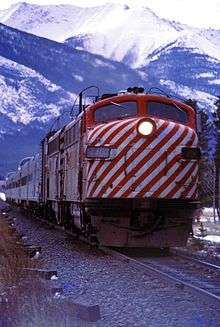
Legacy
For those living outside British Columbia, it is difficult to convey the extent that the CPR empire covered BC. The railroad changed the province; it owned (and dictated to) a large section of it. The CPR's empire became part of BC—from the faux-Pict-Gothic-Palaces of its hotels, to its Tuscan-red cars and engines; from the CPR owning the center of town, to the CPR bloc establishing timber and mineral interests. The clapboard section houses and water towers and rusty rails of spurs, the thousands of wooden wheat boxcars sitting at sidings with the arcing, powerful script announcing "Canadian Pacific Railway"—all left an imprint.

In 1952, the CPR became the first North American railroad to introduce intermodal or "piggyback" freight service, where truck trailers are carried on flatcars. Containers later replaced most piggyback service. Beginning in the 1960s, the railroad started to discontinue much of its passenger service (particularly on its branch lines). Passenger service ended on its line through southern British Columbia and Crow's Nest Pass in January 1964. The Dominion was dropped in January 1966. On October 29, 1978, CP Rail transferred its passenger services to Via Rail, a new federal Crown corporation now responsible for intercity passenger services in Canada. Canadian Prime Minister Brian Mulroney presided over major cuts in Via Rail service on January 15, 1990. This ended service by the Canadian over CPR rails, and the train was rerouted on the former Super Continental route via Canadian National without a change in name. Where both trains had been daily prior to the January 15, 1990 cuts, the surviving Canadian was (and is) a thrice-weekly operation.
The CPR was in a powerful position during the First World War. Canadian Pacific Railway currently operates three commuter services under contract. The West Coast Express comprises ten daily trains running into downtown Vancouver on behalf of TransLink, a regional transit authority. CNCP was created as a joint venture between Canadian Pacific Railway and Canadian National Railway in 1967, replacing the different networks used by the two companies. CN Telegraph interchanged traffic with the Postal Telegraph Cable Company in the US, while CPR Telegraphs networked with Western Union. The two networks—former rivals—had been cooperating increasingly since the 1930s. By 1980, CNCP was no longer a telegraph company and emerged as an early telecom company. A 40 percent stake was acquired by Rogers Communications in 1984, and CP acquired CN's stake. The network was dissolved in 1988, and Rogers renamed the company Unitel Communications Incorporated in 1989.
Other holdings
With the empire came timber, oil, gas, coal, airlines, and real estate. Much of the postwar holdings were in these fields, and the railroad moved into bulk commodities—wheat, potash, coal and sulfur. By the 1970s, the advent of jet aircraft and national highways finished the passenger business.
In the 1980s and 90s the railway continued with traffic expansion. It double tracked most of its mainline, where the mountains and valleys let it. A large tunnelling project under Mount Macdonald, the Mount Macdonald Tunnel in Rogers Pass, lowered the height the trains had to ascend to, as well as significantly reducing the grade for westbound trains, and many riveted bridges were replaced with heavier welded bridges. The Vancouver Intermodal Yard in Pitt Meadows opened in 1996. [8]
See also
Citations
- Belshaw, John Douglas. Canadian History: Post-Confederation. BCcampus.
- Shen, L.; Li, J. B.; Wheate, R.; Yin, J.; Paul, S. S. (2020). "Multi-Layer Perceptron Neural Network and Markov Chain Based Geospatial Analysis of Land Use and Land Cover Change". Journal of Environmental Informatics Letters. doi:10.3808/jeil.202000023. ISSN 2663-6859.
- "Connecting Canada". cpconnectingcanada.ca. Retrieved 2020-03-31.
- Hanley, Ann (October 1958). "Andrew Onderdonk, Master Builder". The Pacific Northwest Quarterly. 49: 146–149 – via JSTOR.
- "Canadian Pacific Railway Ltd. | Canadian company". Encyclopedia Britannica. Retrieved 2020-04-01.
- "Canadian Pacific Railway | The Canadian Encyclopedia". www.thecanadianencyclopedia.ca. Retrieved 2020-03-31.
- Canadian Pacific Railway, Communications and Public Affairs Office (2006). "The Story of the Candian Pacific Railway" (PDF). CP History.
- "Canadian Pacific Railway Ltd. | Canadian company". Encyclopedia Britannica. Retrieved 2020-06-24.
References
- Barrie Sandford. McCulloch's Wonder, Whitecap, Vancouver, 1979.
- Pierre Berton. The Last Spike. M & S, Toronto 1971.
- Robert Turner. West of the Great Divide. Sono Nis. Victoria. 1989.
